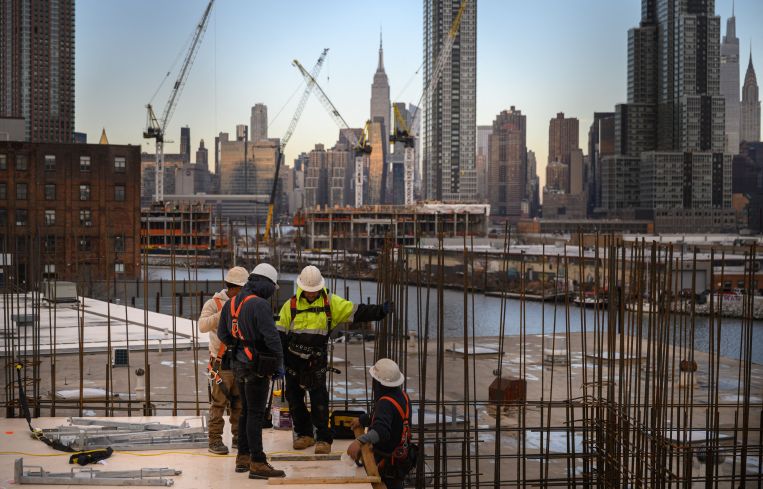Activists and NY Pols Pitch $5B State Agency to Develop Affordable Housing
By Rebecca Baird-Remba February 6, 2024 12:59 pm
reprints
A group of progressive housing activists, labor unions and New York state elected officials are pushing a new solution to solving the housing crisis: a state social housing development authority that would develop housing, funded by a mix of state and local money.
Housing Justice for All, a left-leaning housing policy activist group that worked on the 2019 rent law reforms, is leading the charge for the legislation, which is being sponsored by state Sen. Cordell Cleare and Assembly member Emily Gallagher. It would create a public benefit corporation that could both develop new housing and acquire older properties for preservation.
The plan, first discussed Monday in a City & State op-ed and then in The New York Times Tuesday morning, demands $5 billion from the state government to finance and construct the first round of housing projects and $71 million in initial funding to set up the new agency, to be called the Social Housing Development Authority (SHDA). This new development authority would issue its own debt in the form of tax-exempt bonds to finance projects, and it could also rely on a proposed state-funded voucher program to subsidize low-income tenants.
The proposal — which has the backing of several labor unions including the Building & Construction Trades Council of Greater New York — is based on a project studied by the nonprofit Community Service Society of New York (CSSNY) and modeled by graduate students in Hunter College’s master of urban planning program.
“My constituents want permanently affordable housing that stays 100 percent affordable across generations and allows for people to live, grow and stay in their communities for a lifetime,” Cleare of Harlem said in a statement. “Today, with the introduction of the SHDA, we recognize that housing is an inherent and affirmative public good, no longer subject to and ruled by private greed, displacement and gentrification. The SHDA will allow future generations, such as Black families in Harlem, to stay in the community they love in perpetuity.”
If this sounds reminiscent of New York’s midcentury Mitchell-Lama program, which constructed more than 100,000 apartments statewide using federal subsidy, it is. The Urban Development Corporation, a predecessor to the Empire State Development Corporation, constructed Mitchell-Lama buildings throughout the five boroughs using federal subsidies and required developers, local governments and co-operatives to sign 20- or 30-year agreements that kept them affordable to low- and middle-income tenants. However, some Mitchell-Lama properties have been forced to exit the program — deregulating their units — because they could no longer meet their operating expenses. Activists hope to avoid that pitfall by making the new publicly owned developments financially sustainable.
The new development authority would build and preserve publicly owned rental units, along with rentals and co-ops managed by community land trusts or other “publicly stewarded” entities, according to the proposal. These projects could serve a broad range of incomes, but would still be rent-regulated.
At least a quarter of the units owned by the new state authority would have to serve households earning 30 percent of the area median income, which is $38,130 for a family of three in New York City. The focus would be on developing new buildings on state-owned land and acquiring distressed and underpriced properties throughout New York state.
It’s not entirely clear how the state — which is facing a $4.3 billion budget gap for 2024 — would fund this effort. In its proposal, Housing Justice for All suggests that the state could create a new tax or have voters approve a new revenue bond on a statewide ballot.
Revenue generated by the buildings that exceed their operating costs would go into a general revolving fund and be available for future maintenance, said Sam Stein, a housing policy analyst at CSSNY who worked on the plan.
Laura Wolf-Powers, a professor at Hunter College, oversaw the graduate project on which the proposal is based and said it helps “get people thinking” about new ways to fund affordable housing construction.
“Right now the cost of producing below-market housing is high because there are a lot of transaction costs” for securing low-income housing tax credits (LIHTC) and other forms of financing, as well as developer fees, Wolf-Powers said. She argued that a public development arm could avoid some of these financing costs, as well as circumvent other limits that private developers face, like the federal cap on tax-exempt bond financing used to generate LIHTCs, a common affordable housing subsidy.
“What could we do if we capitalized a public developer that was fiscally responsible, politically savvy, that was managed by people who understand housing finance and connected to grassroots organizations whose members are interested in resident control models?” Wolf-Powers asked.
The proposal also comes as state legislators, housing activists, and the real estate industry fight over a replacement for the 421a tax exemption, which for years propped up much of the rental development in the five boroughs but expired in June 2022. Gov. Kathy Hochul proposed a replacement in 2022, 485-w, which did not satisfy activists or unions. The latest iteration of the proposal, 485-x, is still up in the air, and leaves the most thorny part of the legislation — the wage requirements — up to the construction unions and the Real Estate Board of New York.
REBNY, for its part, was deeply skeptical of the new social housing authority proposal.
“While we look forward to reviewing this legislation in more detail, solving our housing crisis will require data-driven solutions, not idealism and ideology,” the group said in a statement.
Rebecca Baird-Remba can be reached at rbairdremba@commercialobserver.com.


